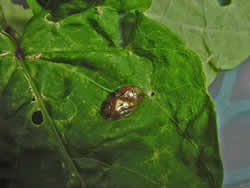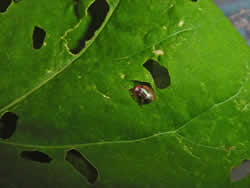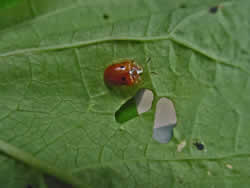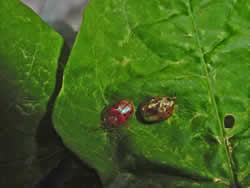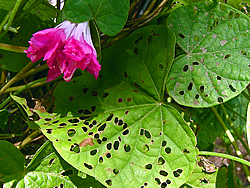Search
For The Answer
Click here to access our database of
Plant Answers
Search
For The Picture
Click here to access the Google database of plants
and insects
Information
Index
Alphabetical Listing of Topics, Recommendations
and Plants
Milberger's Nursery and Landscaping
3920 North Loop 1604 E.
San Antonio, TX 78247
210.497.3760
nursery@milbergersa.com
Open 9 to 6 Mon. through Sat.
and 10 to 5 on Sun.

Three exits east of 281, inside of 1604
Next to the Diamond Shamrock station
Please click map for more detailed map and driving directions.
QUESTION: Can Lady Bugs be golden?
ANSWER: I had NEVER seen a golden Lady Bug-type beetle until this spring, 2008. I find that it is a Golden Tortoise Beetle: Metriona bicolor, family Chrysomelidae The golden tortoise beetle is a stunning, vibrant metallic gold color. It has a magical quality, not only because of the brilliance of its color, but also because the brilliance isn't permanent. Metriona can alter color within a short time period, turning from brilliant gold to a dull, spotty reddish color. The gold color also fades when the insect dies. The gold color is caused by a thin layer of moisture between the cuticle and an inner layer of the elytra. Apparently the insect is able to "voluntarily" squeeze this layer, reducing its thickness and eliminating the gold color. This change also occurs involuntarily when the beetle is under moisture stress, and when it dies. A bit smaller than the more familiar ladybird beetles, the golden tortoise beetle is configured somewhat like a safari hat with a narrow "shelf" skirting the outside of the wing covers and thorax. This "shelf" causes the resemblance to a tortoise, hence the name. Tortoise beetles are plant eaters. The golden tortoise beetle in particular feeds on morning glory. They reside under the leaf, eating a series of small holes resulting in a characteristic damage pattern. The larval stage of Metriona is at least as interesting as the adult, though perhaps not as magical. The larvae also feed on the underside of morning glory leaves. When they shed their skin, it remains attached to a prong-like process at the end of the abdomen. Molts are stacked on molts, and are carried around held over the insect's back like a parasol. "Parasol beetles" is indeed another common name for tortoise beetles. When disturbed, the larvae wave the parasol about, no doubt to intimidate or distract potential predators. Tortoise beetles overwinter as adults. In the spring the adults begin to feed, mate, and lay eggs. More close-up images can be seen at: http://www.biol.uni.wroc.pl/cassidae/katalog%20internetowy/charidotellasexpunctatafig.htm |
||||||




